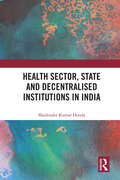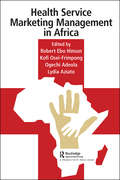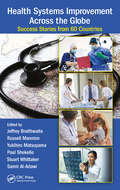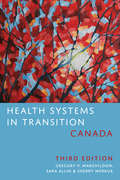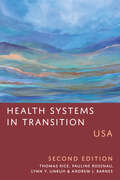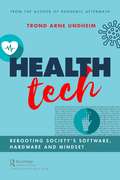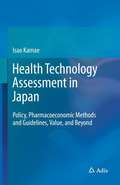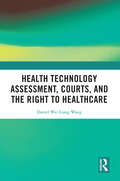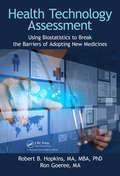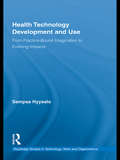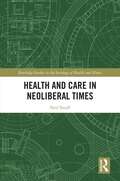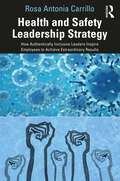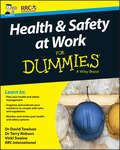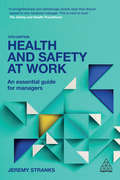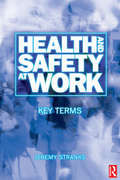- Table View
- List View
Health Rights of Older People: Comparative Perspectives in Southeast Asia (Routledge-GRIPS Development Forum Studies)
by Long Thanh Giang Theresa W. DevasahayamThe book examines the health rights of older persons who are more likely potentially to face various disadvantages in terms of healthcare access and affordability, thereby impacting on health outcomes. The point of departure in the analyses is that the health security of older persons is guaranteed only if a country approaches the health of its citizens out of moral obligation, viewing health and well-being as a right rather than an entitlement. Data from five countries in the ASEAN region are analysed with the intent of highlighting the health inequalities and barriers at the societal and individual levels, on the one hand, as well as the gaps at the health and healthcare policy and programmatic levels within each country, on the other. It is also intended that the analyses of the data from the selected countries which represent different stages of development, and thus income levels, provide a useful comparative framework for policymakers in the ASEAN region.
Health Sector, State and Decentralised Institutions in India
by Shailender Kumar HoodaThis book describes the transition in Indian healthcare system since independence and contributes to the ongoing debate within development and institutional economics on the approaches towards reform in the public health system. The institutional reform perspective focuses on examining the effective utilisation of allotted resources and improvements in delivery through decentralisation in governance by ensuring higher participation of elected governments and local communities in politics, policymaking and delivery of health services. It discusses the economic (resource) reforms to explain the relevance and expansion of state interventionism along with its influence on the health sector, accountability and allocative efficiency. The author also explores the connections between neoliberal thought and privatisation in health sector, and examines the greater role of insurance-based financing and their implications for health service access and delivery. The book offers ways to address long-standing systemic and structural problems that confront the Indian healthcare system. Based on large-scale surveys and diverse empirical data on the Indian economy, this book will be of great interest to researchers, students and teachers of health economics, governance and institutional economics, political economy, sociology, public policy, regional studies and development studies. This will be useful to policymakers, health economists, social scientists, public health experts and professionals, and government and nongovernment institutions.
Health Service Marketing Management in Africa
by Robert Ebo Hinson Kofi Osei-Frimpong Ogechi Adeola Lydia AziatoHealth Service Marketing Management in Africa (978-0-429-40085-8, K402492) Shelving Guide: Business & Management / Marketing Management The application of marketing to healthcare is a fascinating field that will likely have more impact on society than any other field of marketing. It’s been theorized that an intrinsically unstable environment characterizes this very relevant emerging field, hence raising new questions. Changing regulations, discoveries, and new health treatments continuously appear and give rise to such questions. Advancements in technology not only improve healthcare delivery systems but also provide avenues for customers to seek information regarding their health conditions and influence their participatory behaviors or changing roles in the service delivery. Increasingly, there is a shift from a doctor-led approach to a more patient-centered approach. In Africa, the importance of marketing-driven practices in improving the delivery of healthcare services cannot be overemphasized. The issue of healthcare delivery and management is significant for policymakers, private sector players, and consumers of health-related services in developing economy contexts. Scholars have strongly argued in favor of marketing and value creation in healthcare service delivery in Africa. Each country in Africa has its own issues. For example, long waiting times, unavailable medications, and unfriendly staff are just a sampling of issues affecting the acceptability of healthcare services. These examples highlight the need to utilize marketing and value creation tools in the delivery of healthcare services. Furthermore, there is a need for the integration of service marketing and management principles to enhance the delivery of quality healthcare across Africa and other developing economies which is the critical focus of this book. This book responds to calls for quality healthcare service management practices or processes from developing economy perspectives. Focusing primarily on African and other developing economy contexts, this book covers seven thematic areas: strategy in healthcare; marketing imperatives in healthcare management; product and pricing management in healthcare; distribution and marketing communications in healthcare; managing people in healthcare; physical evidence and service quality management in healthcare; and process management in healthcare.
Health Stop (B): The Medical Offices
by Regina E. HerzlingerDescribes the long waiting time experienced by customers in Health Stops and asks students to specify the changes in its business model which could help solve the problem.
Health Stop (B): The Medical Offices
by Regina E. HerzlingerDescribes the long waiting time experienced by customers in Health Stops and asks students to specify the changes in its business model which could help solve the problem.
Health Stop Retail Medical Centers (A): Strategy
by Regina E. Herzlinger Nancy M. Kane Joyce LallmanReviews the different business models of for-profit chains that provide ambulatory health care services and asks the students to evaluate which is most likely to do good and do well. It is an effective case for introducing the framework for how to evaluate health care innovations.
Health Stop Retail Medical Centers (A): Strategy
by Regina E. Herzlinger Nancy M. Kane Joyce LallmanWill Health Stop's strategy and business model enable it to succeed against the many other retail medical center innovations described in the case and why? Health Stop, staffed by doctors and located in the malls of wealthy suburbs, is competing against retail medical centers with very different business models. These include: CVS Minute Clinic (CVS' walk-in clinic), One Medical (a concierge service for primary care), Iora Health (a primary care model charging its members a monthly fixed amount as opposed to the traditional fee-for-service model), and ChenMed (a clinic focused on elderly patients with multiple chronic diseases.) Accompanying this case are the following instructional materials: An analytic framework for discussing the questions in the case. It is Chapter 1, Innovating in Healthcare: Creating Breakthrough Services, Products, and Business Models, Regina E. Herzlinger, Wiley 2022
Health Systems Improvement Across the Globe: Success Stories from 60 Countries
by Jeffrey Braithwaite Russell Mannion Yukihiro Matsuyama Paul Shekelle Stuart Whittaker Samir Al-AdawiFollowing on from 2015’s Healthcare Reform, Quality and Safety: Perspectives, Participants, Partnerships and Prospects in 30 Countries, this book encompasses a global perspective on healthcare while shifting the focus from reform to showcasing success stories of healthcare systems worldwide. It provides explanations of why various facets of healthcare systems work well in different contexts and offers the reader alternative models for consideration. The book features contributions from 60 countries, going much further than the common practice of focusing on affluent Western nations, to provide a comprehensive exploration of the success of healthcare systems globally. The majority of literature on health-sector improvement attempts to address the problems within systems, relating the errors that can and do occur, for example, and offering solutions and preventative strategies. This book of country case studies will approach the enhancement of health systems, patient safety and the quality of care in a new and innovative way, comprehensively surveying and synthesizing the success stories of healthcare systems around the world, utilizing Hollnagel’s Safety-II approach to acknowledge the importance of exploring what goes right, what works well, and why it works. These success stories may include reference to macro, meso or micro levels of healthcare systems, various sectors (e.g., aged care, acute care or primary care), or specific programs or projects. Health System Improvement Across the Globe: Success Stories from 60 Countries is unprecedented in terms of both reach and positive emphasis, and as such will be instrumental in changing ways of thinking about and guiding health-sector improvement.
Health Systems in Transition: Canada, Third Edition
by Gregory Marchildon Sherry Merkur Sarah AllinThe health care system in Canada receives a great deal of international attention, but it is subject to considerable critique and debate locally. Health Systems in Transition: Canada provides an insightful and objective analysis of the organization, governance, financing, and delivery of health care as well as comparisons between the Canadian system and others internationally. This book draws on a wide range of empirical studies and statistical data within Canada and across comparable countries to provide a thorough description of the many facets of health care in Canada. Drawing on the most reliable and recent data available, this study reveals the strengths and weakness of Canadian health care. This assessment is based on numerous comparisons of Canada to peer countries (Australia, France, Germany, Netherlands, Sweden, the United Kingdom, and the United States) and among provinces and territories within Canada. It will be of interest to scholars and students in Canada wanting to learn more about the largest and most celebrated public program, and for those outside Canada interested in comparative systems and policy research.
Health Systems in Transition: USA, Second Edition
by Thomas Rice Pauline Rosenau Lynn Y. Unruh Andrew J. BarnesThis analysis of the United States health care system reviews developments in organization and governance, health financing, health care provision, health reforms, and health system performance. The U.S. system has both considerable strengths and notable weaknesses. It has a large and well-trained health workforce, a wide range of high-quality medical specialists as well as secondary and tertiary institutions, a robust health sector research program, and, for selected services, among the best medical outcomes in the world. But it also suffers from incomplete coverage of its citizenry, health expenditure levels per person far exceeding all other countries, poor objective and subjective indicators of quality and outcomes, and an unequal distribution of resources and outcomes across the country and among different population groups. Because of the adoption of the Affordable Care Act in 2010, and subsequent revisions to it, the U.S. is facing a period of enormous change. There is a great need to improve coverage and improve equity, better ensure quality outcomes, and find ways to better control expenditures. Health Systems in Transition: USA provides an in-depth discussion of these issues and a thorough review of the U.S. health care system.
Health Systems in the Developing World
by Kevin Schulman Gary Carbell Muhammed PateThis teaching note offers an approach to the evaluation of health care markets globally. The note prepares students with a set of questions about the organization of core elements of the health care system. The organization of these elements can vary across markets, and can vary in terms of the different roles of the public and private sector in financing and delivery of health care services. Overall, the framework provides an opportunity for a structured analysis of any market in health care, and provides students with a comprehensive approach to assessing the current health care market. Students can build from this framework with their own assessments of potential opportunities for business or policy innovation within the market.
Health Tech: Rebooting Society's Software, Hardware and Mindset
by Trond Arne UndheimGlobal healthcare will change drastically in the next decade due to key technologies, social dynamics, and systemic shifts that are already in motion. However, shaping the future requires being aware of the opportunities and able to capitalize on them to one’s family and the community’s benefit. Health tech can be a part of the solution, but tracking the right startups and influencers takes know-how. The grand challenges of our time demand that we coordinate better than ever before. Social movements can both accelerate and slow down change. Health systems across the world need to reboot, with private partnerships and new governance paradigms that have global reach but local legitimacy, but exactly how can this be done considering the collective action problem and complexity involved? Health Tech: Transforming Public Health Innovation at the Edge fulfills the need for actionable insight on what’s truly driving change and how to become a changemaker, not just affected by it. The book introduces anybody who wishes to understand how global healthcare will change in the next decade to key technologies, social dynamics, and systemic shifts that are shaping the future. Healthcare Futurist, investor and entrepreneur, Trond Undheim, describes the complex history of public health, why it’s so complicated and what the major challenges right now. He includes a discussion of COVID, why it happened, the cultural factors that has slowed down traditional public health measures and how innovation can help. He also discusses what is happening in health systems around the world as a result of the pandemic. The book also explores certain health tech measures, tools (basic medical devices gradually being upgraded and digitally enhanced), processes and innovation which are already working well, and others that are in their infancy such as AI, wearables, robotics, sensors, digital therapeutics and others. The author also describes the movers and shakers in the healthcare system of the future from startups to patients and services providers and the health challenges of our time including the pandemic, aging and preventive healthcare and much more. The book concludes with a look at how health tech may provide the biggest opportunity to transform healthcare for decades to come.
Health Technology Assessment in Japan: Policy, Pharmacoeconomic Methods and Guidelines, Value, and Beyond
by Isao KamaeRepresenting the first book on the topic, this work offers the reader an introduction to the Japanese systems for health technology assessment (HTA) officially introduced by the Ministry of Health, Labour and Welfare (MHLW) in 2016. Policy and guidelines are discussed, with the relevant methods and conditions of cost-effectiveness analysis explained alongside. Numerous instructive examples and exercises, ranging from basic to advanced, impart valuable knowledge and insight on the quantitative methods for economic evaluation, which will appeal to both beginners and experts.This guidebook is authored by Japan’s foremost expert in HTA and pharmacoeconomics, with a view to strengthening the reader’s expertise in value-based healthcare and decision-making. The methods presented are essential to informing regulatory, local and patient decisions; as such, the book is equally recommended to industry and government, as well as academia, and anyone with an interest in Japanese HTA.
Health Technology Assessment, Courts and the Right to Healthcare
by Daniel Wei WangBoth developing and developed countries face an increasing mismatch between what patients expect to receive from healthcare and what the public healthcare systems can afford to provide. Where there has been a growing recognition of the entitlement to receive healthcare, the frustrated expectations with regards to the level of provision has led to lawsuits challenging the denial of funding for health treatments by public health systems. This book analyses the impact of courts and litigation on the way health systems set priorities and make rationing decisions. In particular, it focuses on how the judicial protection of the right to healthcare can impact the institutionalization, functioning and centrality of Health Technology Assessment (HTA) for decisions about the funding of treatment. Based on the case study of three jurisdictions – Brazil, Colombia, and England – it shows that courts can be a key driver for the institutionalization of HTA. These case studies show the paradoxes of judicial control, which can promote accountability and impair it, demand administrative competence and undermine bureaucratic capacities. The case studies offer a nuanced and evidence-informed understanding of these paradoxes in the context of health care by showing how the judicial control of priority-setting decisions in health care can be used to require and control an explicit scheme for health technology assessment, but can also limit and circumvent it. It will be essential for those researching Medical Law and Healthcare Policy, Human Rights Law, and Social Rights.
Health Technology Assessment: Using Biostatistics to Break the Barriers of Adopting New Medicines
by Robert B. Hopkins MA MBA PhD Ron Goeree MAThe term health technology refers to drugs, devices, and programs that can improve and extend quality of life. As decision-makers struggle to find ways to reduce costs while improving health care delivery, health technology assessments (HTA) provide the evidence required to make better-informed decisions.This is the first book that focuses on the s
Health Technology Development and Use: From Practice-Bound Imagination to Evolving Impacts (Routledge Studies in Innovation, Organizations and Technology)
by Sampsa HyysaloHow do development and use of new technology relate? How can users contribute to innovation? This volume is the first to study these questions by following particular technologies over several product launches in detail. It examines the emergence of inventive ideas about future technology and uses, how these are developed into products and embedded in health care practices, and how the form and impact of these technologies then evolves through several rounds of design and deployment across different types of organizations. Examining these processes through three case studies of health care innovations, these studies reveal a blind spot in extant research on development-use relations. The majority of studies have examined shorter ‘episodes’: moments within particular design projects, implementation processes, usability evaluations, and human-machine interactions. Studies with longer time-frames have resorted to a relatively coarse ‘grain-size’ of analysis and hence lost sight of how the interchange is actually done. As a result there are no social science, information systems, or management texts which comprehensively or adequately address: • how different moments, sites and modes of shaping new technology determine the evolution of new technology; • the detailed mechanisms of learning, interaction, and domination between different actors and technology during these drawn out processes; and • the relationship of technology projects and the professional practices and social imaginations that are associated in technology development, evaluation, and usage. The "biographies of technologies and practices" approach to new technology advanced in this volume offers us urgent new insight to core empirical and theoretical questions about how and where development projects gain their representations of future use and users, how usage is actually designed, how users’ requests and modifications affect designs, and what kind of learning takes place between developers and users in different phases of innovation—all crucial to our understanding and ability to advance new health technology, and innovation more generally.
Health and Animal Agriculture in Developing Countries
by David Zilberman Dirk Pfeiffer Joachim Otte David Roland-HolstThis book provides an overview of the state of animal agriculture and present methodologies and proposals to develop policies that result in sustainable and profitable animal production that will protect human and environmental health, enhance livelihood of smallholders and meet consumer needs. The book combines lessons of the past, factual foundation to understand the present, analytical tools to design and improve policies, case studies that provide both empirical grounding and applications of some of the strategies suggested in this book, and finally, a proposal for the way forward.
Health and Care in Neoliberal Times
by NEIL SMALLThis book argues that neoliberal changes in health and social care go beyond resource allocations, priority setting and privatisation, and manifest in an invidious erosion of the quality of our social relationships, including relationships between care provider and care recipient. Critically examining the concept of culture and why shifts in what is considered "acceptable practice" happen, the book explores the conduct of conduct. It draws together what we know about neoliberalism’s impact on the economy and public services with research around governmentality and social change. Looking at breakdowns in the quality of care in the NHS and social care across a range of settings it holds that macro influences, such as austerity and marketisation, cannot explain everything and many of the damaging things that go on in care breakdowns occur in micro-interactions between care provider and care recipient. Analysing the interactions between the calculations of political centres, the strength of professional identities, the effectiveness of oversight and supervision and the biographies of protagonists, Neil Small problematises the focus on culture, and culture change, in our response to care failures and examines what a different approach to care might involve. Exploring the interaction of politics, economics and social change and their impact on health care and the wider welfare state, this is an important contribution for students and researchers in health and social care, sociology, political science and management studies.
Health and Education Reforms in Rural China (Routledge Studies in the Modern World Economy)
by Li LiChina witnessed an unprecedented economic boom in the past four decades but will soon see the end of "demographic dividend". With shrinking labor, improving the quality of human capital could be one way to maintain China’s remarkable growth. The population in rural China accounts for 41% of the total population in China but the human capital development in rural China lags far behind the urban cities. This book selects four major reforms on education and health in rural China and evaluates the impact of these reforms on human capital development. Through rigorous econometric analysis, the book looks at factors of the rural-urban gap in human capital and the causal relationship between the reforms and the human capital development. This book will be a useful reference for developing economies which are facing similar issues in the labor market.
Health and Education in Early Childhood
by Arthur J. Reynolds Arthur J. Rolnick Judy A. Temple Arthur J. Reynolds Arthur J. RolnickHealth and Education in Early Childhood presents conceptual issues, research findings, and program and policy implications in promoting well-being in health and education in the first five years of life. Leading researchers in the multidisciplinary fields of early learning and human capital formation explore the themes of the integration of health and education in promoting young children's well-being; the timing of influences on child development; and the focus on multiple levels of strategies to promote healthy early development. Through this, a unique framework is provided to better understand how early childhood health and education predictors and interventions contribute to well-being at individual, family community, and societal levels and to policy development. Key topics addressed in the chapters include nutritional status, parenting, cognitive development and school readiness, conduct problems and antisocial behavior, obesity, and well-being in later childhood and adulthood.
Health and Prosperity: Efficient Health Systems for Thriving Nations in the 21st Century
by Fabrice MurtinMurtin examines the long-term causes of health improvements over the last two centuries. Focusing on the relative importance of income and education, Murtin finds that education alone accounts for the bulk of health improvements since 1870, and explains the strong correlation between longevity and income, which is highly correlated with education. Conversely, the book shows that progress in longevity has had dramatic consequences on societies, as it reduced fertility, triggered the spread of education, spurred economic growth, and improved 'prosperity' in a way that is comparable to the long-term rise in income. Health and Prosperity sheds light on the real cost of health systems in the 21st century.
Health and Safety Leadership Strategy: How Authentically Inclusive Leaders Inspire Employees to Achieve Extraordinary Results
by Rosa Antonia CarrilloThe purpose of this book is to awaken leaders to the unique opportunities now present in the areas typically delegated to Health and Safety. It is a strategy to utilize existing resources to fully develop and engage human potential to catapult business achievement. The confluence of Covid-19, the resulting burnout, the attention on diversity, equity and inclusion generated by the Black Lives Matter movement and the ‘great resignation’ continues to create openings to fundamentally change how we address personal development, sustainable growth and social responsibility. The argument within is that the better we manage the social aspects of the organization, the better our business results. Elucidating to the reader the societal shifts of workplace culture in recent years, this text expertly analyzes the importance of mental health in the workplace, whilst also explaining how management and HR departments can improve. It examines who is responsible for generating psychological safety and provides relationship strategies that will improve performance. The critiques in this text establish why it is imperative for business leaders to concentrate on how their company culture affects their employees, and whether their employees feel safe, seen and supported. The concepts and practices in this book are the ones that leaders have used across the ages to create commitment, accountability and excellence. Managers will benefit from a deeper understanding of how these issues impact every aspect of organizational performance. This book is essential reading for executives, leaders and those interested in leadership. They could be in the C-suite, operations, health and safety and HR. It is also directly relevant to organization development and change management specialists interested in including safety within their practice.
Health and Safety at Work For Dummies
by RrcAre you complying with health and safety regulations in the workplace? Making mistakes in many areas of health and safety can be both incredibly dangerous and hugely costly. So what can you do to avoid hazards and expensive, time-consuming legal battles? That's where Health & Safety at Work For Dummies comes in. Cutting through the clutter, it provides you with the practical, must-know information you need to ensure your workplace is a suitably safe environment that complies with government health and safety rules and regulations. Did you know that in 2014, 1.2 million working people suffered from work-related illnesses, 2,535 mesothelioma deaths occurred due to past asbestos exposure and 133 workers were killed on the job? The list goes on - and the statistics are staggering. Health & Safety at Work For Dummies shows you how to keep your employees safe from becoming another statistic in this frightening data. Arming you with critical information needed to adhere to health and safety regulations, it offers expert guidance on managing and implementing health and safety in your business, controlling workplace risks, going the extra mile in following orders and much more. Offers an easy-to-follow overview for getting started with health and safety Provides tips and advice for planning your health and safety management Includes guidance on monitoring and reviewing your health and safety systems Clearly demonstrates how to organize and motivate your workforce to comply with rules and regulations You can't afford to run a business that doesn't provide a safe work environment. Be smart, safe and proactive with the help of this essential guide.
Health and Safety at Work: An Essential Guide for Managers
by Jeremy StranksThis practical guide continues to provide managers with the essential advice on how to establish health and safety procedures in organizations. Written in jargon-free language, Health and Safety at Work cuts through the legal complexities to enable you to fully understand the law and its implications for your business. Filled with expert knowledge and written in an accessible style, this book equips you with the legal and practical knowledge you need to protect your employees and your business. This 10th Edition of the indispensable guide, Health and Safety at Work, has been updated to comply with all recent changes and additions to Health and Safety law including The Reporting of Injuries, Diseases and Dangerous Occurrences Regulations 2013, The Construction (Design and Management) Regulations 2015 and increased legislation and prioritisation of issues of stress at work. This new edition also comes with downloadable online resources and templates that you can use in your business.
Health and Safety at Work: Key Terms
by Jeremy StranksHealth and Safety at Work: Key Terms provides instant information to readers on a range of key terms used in health and safety at work. The book, produced in A-Z format, incorporates the principal legal, technical and practical terms derived from statutes, regulations, approved codes, case law and other appropriate publications. As such, it will be of particular use to health and safety practitioners, those studying for degrees in occupational health and safety and courses run by NEBOSH, and those engaged in enforcement activities, such as Health and Safety Executive inspectors, environmental health officers and fire protection officers.The key terms referenced and explained include: accident statistics; absolute duties; distance guard; noise-induced hearing loss; oxidising classifications; relevant statutory provisions.

